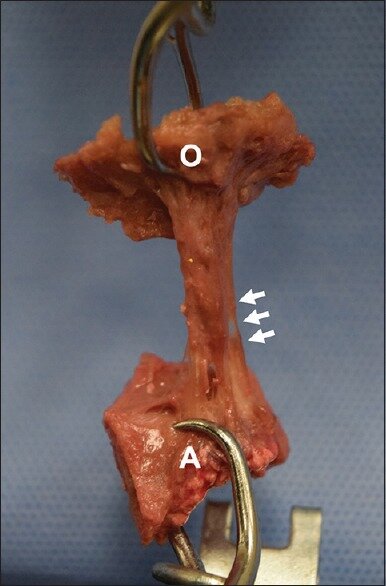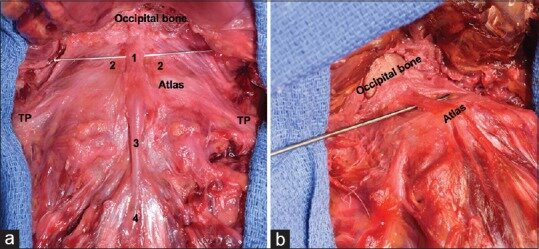Superficial anterior atlanto-occipital ligament: Anatomy of a forgotten structure with relevance to craniocervical stability.
J Craniovertebr Junction Spine. 2019 Jan-Mar;10(1):42-45. doi: 10.4103/jcvjs.JCVJS_110_18.
Abstract
INTRODUCTION:
The superficial anterior atlanto-occipital ligament (SAAOL) is a narrowband located anterior to the anterior atlanto-occipital membrane. Nearly forgotten, it has not been well described in older anatomical textbooks and is missing in the current anatomical literature. As all of the binding structures of the craniocervical junction (CCJ) are important in maintaining stability, this study aims to clarify the anatomy and potential function of the SAAOL.
MATERIALS AND METHODS:
The CCJ from ten fresh-frozen cadavers was studied. These specimens were derived from three males and seven females, and the age at death ranged from 57 to 91 years (mean, 79.8 years). The length, width, and thickness of the SAAOL were measured. In five specimens, the force to failure was recorded.
RESULTS:
The SAAOL was found between the anterior tubercle of the atlas and the occiput and located as central thick fibers in front of the anterior atlanto-occipital membrane in 9 (90%) specimens. In one specimen, the vertical band to the occipital bone did not attach to the anterior tubercle of the atlas, but extended to the anterior aspect of the axis. The mean length, width, and thickness of the SAAOL were 19.8, 6.2, and 0.6 mm, respectively. The force to failure for the ligament was 38.8 N.
CONCLUSION:
The SAAOL was a constant structure of the anterior atlanto-occipital joint. This ligament seems to be a secondary stabilizer of the CCJ by limiting the extension of CCJ. Knowledge of this ligament may help in further understanding of craniocervical stability.
KEYWORDS:
Anatomy; cadaver; cervical vertebra; craniocervical joint; ligaments



